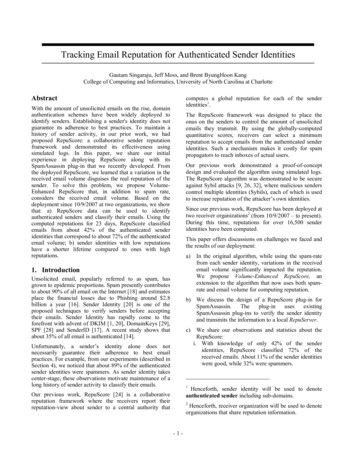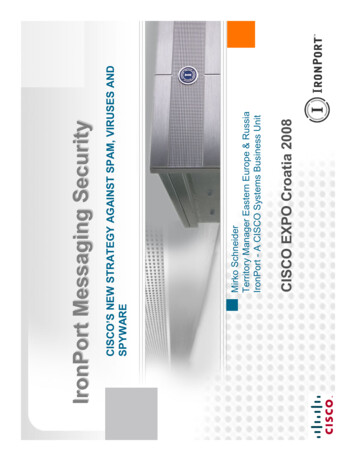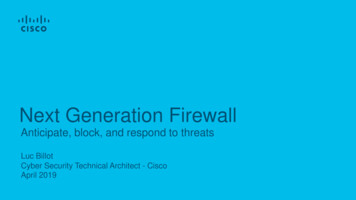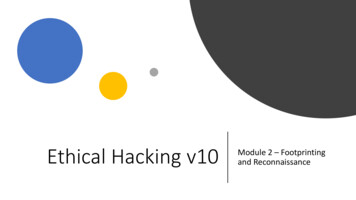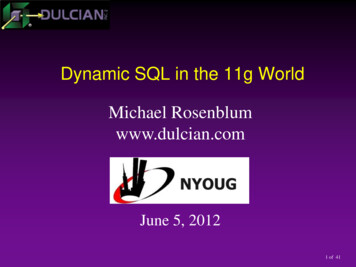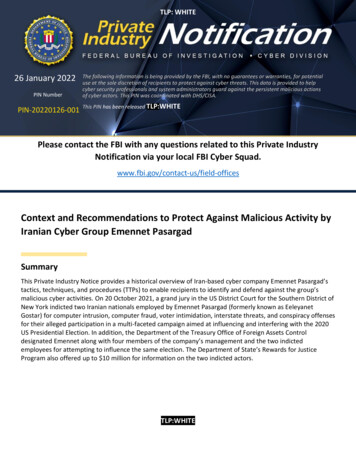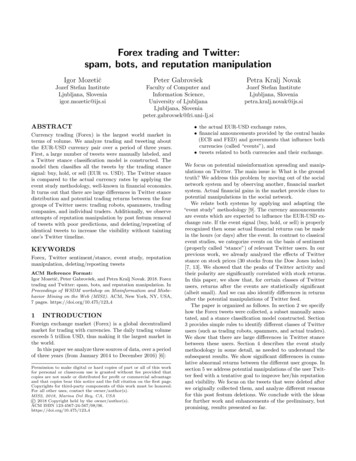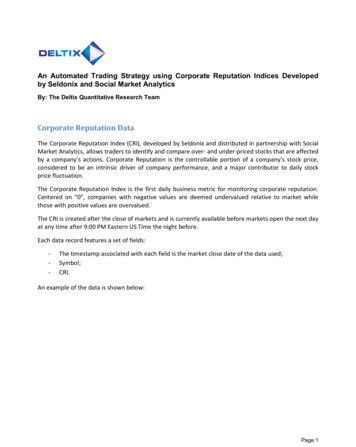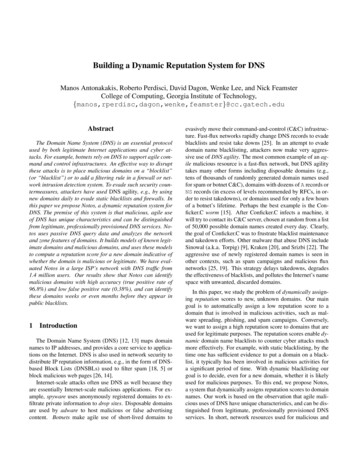
Transcription
Building a Dynamic Reputation System for DNSManos Antonakakis, Roberto Perdisci, David Dagon, Wenke Lee, and Nick FeamsterCollege of Computing, Georgia Institute of c.gatech.eduAbstractThe Domain Name System (DNS) is an essential protocolused by both legitimate Internet applications and cyber attacks. For example, botnets rely on DNS to support agile command and control infrastructures. An effective way to disruptthese attacks is to place malicious domains on a “blocklist”(or “blacklist”) or to add a filtering rule in a firewall or network intrusion detection system. To evade such security countermeasures, attackers have used DNS agility, e.g., by usingnew domains daily to evade static blacklists and firewalls. Inthis paper we propose Notos, a dynamic reputation system forDNS. The premise of this system is that malicious, agile useof DNS has unique characteristics and can be distinguishedfrom legitimate, professionally provisioned DNS services. Notos uses passive DNS query data and analyzes the networkand zone features of domains. It builds models of known legitimate domains and malicious domains, and uses these modelsto compute a reputation score for a new domain indicative ofwhether the domain is malicious or legitimate. We have evaluated Notos in a large ISP’s network with DNS traffic from1.4 million users. Our results show that Notos can identifymalicious domains with high accuracy (true positive rate of96.8%) and low false positive rate (0.38%), and can identifythese domains weeks or even months before they appear inpublic blacklists.1 IntroductionThe Domain Name System (DNS) [12, 13] maps domainnames to IP addresses, and provides a core service to applications on the Internet. DNS is also used in network security todistribute IP reputation information, e.g., in the form of DNSbased Block Lists (DNSBLs) used to filter spam [18, 5] orblock malicious web pages [26, 14].Internet-scale attacks often use DNS as well because theyare essentially Internet-scale malicious applications. For example, spyware uses anonymously registered domains to exfiltrate private information to drop sites. Disposable domainsare used by adware to host malicious or false advertisingcontent. Botnets make agile use of short-lived domains toevasively move their command-and-control (C&C) infrastructure. Fast-flux networks rapidly change DNS records to evadeblacklists and resist take downs [25]. In an attempt to evadedomain name blacklisting, attackers now make very aggressive use of DNS agility. The most common example of an agile malicious resource is a fast-flux network, but DNS agilitytakes many other forms including disposable domains (e.g.,tens of thousands of randomly generated domain names usedfor spam or botnet C&C), domains with dozens of A records orNS records (in excess of levels recommended by RFCs, in order to resist takedowns), or domains used for only a few hoursof a botnet’s lifetime. Perhaps the best example is the Conficker.C worm [15]. After Conficker.C infects a machine, itwill try to contact its C&C server, chosen at random from a listof 50,000 possible domain names created every day. Clearly,the goal of Conficker.C was to frustrate blacklist maintenanceand takedown efforts. Other malware that abuse DNS includeSinowal (a.k.a. Torpig) [9], Kraken [20], and Srizbi [22]. Theaggressive use of newly registered domain names is seen inother contexts, such as spam campaigns and malicious fluxnetworks [25, 19]. This strategy delays takedowns, degradesthe effectiveness of blacklists, and pollutes the Internet’s namespace with unwanted, discarded domains.In this paper, we study the problem of dynamically assigning reputation scores to new, unknown domains. Our maingoal is to automatically assign a low reputation score to adomain that is involved in malicious activities, such as malware spreading, phishing, and spam campaigns. Conversely,we want to assign a high reputation score to domains that areused for legitimate purposes. The reputation scores enable dynamic domain name blacklists to counter cyber attacks muchmore effectively. For example, with static blacklisting, by thetime one has sufficient evidence to put a domain on a blacklist, it typically has been involved in malicious activities fora significant period of time. With dynamic blacklisting ourgoal is to decide, even for a new domain, whether it is likelyused for malicious purposes. To this end, we propose Notos,a system that dynamically assigns reputation scores to domainnames. Our work is based on the observation that agile malicious uses of DNS have unique characteristics, and can be distinguished from legitimate, professionally provisioned DNSservices. In short, network resources used for malicious and
fraudulent activities inevitably have distinct network characteristics because of their need to evade security countermeasures. By identifying and measuring these features, Notos canassign appropriate reputation scores.Notos uses historical DNS information collected passivelyfrom multiple recursive DNS resolvers distributed across theInternet to build a model of how network resources are allocated and operated for legitimate, professionally run Internet services. Notos also uses information about malicious domain names and IP addresses obtained from sources such asspam-traps, honeynets, and malware analysis services to builda model of how network resources are typically allocated byInternet miscreants. With these models, Notos can assign reputation scores to new, previously unseen domain names, therefore enabling dynamic blacklisting of unknown malicious domain names and IP addresses.Previous work on dynamic reputation systems mainly focused on IP reputation [24, 31, 1, 21]. To the best of ourknowledge, our system is the first to create a comprehensivedynamic reputation system around domain names. To summarize, our main contributions are as follows: We designed Notos, a dynamic, comprehensive reputation system for DNS that outputs reputation scores fordomains. We constructed network and zone features thatcapture the characteristics of resource provisioning, usages, and management of domains. These features enableNotos to learn models of how legitimate and maliciousdomains are operated, and compute accurate reputationscores for new domains. We implemented a proof-of-concept version of our system, and deployed it in a large ISP’s DNS network inAtlanta, GA and San Jose, CA, USA, where we observed DNS traffic from 1.4 million users. We also usedpassive DNS data from Security Information Exchange(SIE) project [3]. This extensive real-world evaluationshows Notos can correctly classify new domains witha low false positive rate (0.38%) and high true positiverate (96.8%). Notos can detect and assign a low reputation score to malware- and spam-related domain namesseveral days or even weeks before they appear on publicblacklists.Section 2 provides some background on DNS and relatedworks. Readers familiar with this may skip to Section 3, wherewe describe our passive DNS collection strategy and otherwhitelist and blacklist inputs. We also describe three feature extraction modules that measure key network, zone andevidence-based features. Finally, we describe how these features are clustered and incorporated into the final reputationengine. To evaluate the output of Notos, we gathered an extensive amount of network trace data. Section 4 describes thedata collection process, and Section 5 details the sensitivity ofeach module and final output.2Background and Related WorkDNS is the protocol that resolves a domain name, likewww.example.com, to its corresponding IP address, for example 192.0.2.10. To resolve a domain, a host typicallyneeds to consult a local recursive DNS server (RDNS). A recursive server iteratively discovers which Authoritative NameServer (ANS) is responsible for each zone. The typical resultof this iterative process is the mapping between the requesteddomain name and its current IP addresses.By aggregating all unique, successfully resolved A-typeDNS answers at the recursive level, one can build a passiveDNS database. This passive DNS (pDNS) database is effectively the DNS fingerprint of the monitored network andtypically contains unique A-type resource records (RRs)that were part of monitored DNS answers. A typical RRfor the domain name example.com has the following format: {example.com. 78366 IN A 192.0.2.10},which lists the domain name, TTL, class, type, and rdata. Forsimplicity, we will refer to an RR in this paper as just a tupleof the domain name and IP address.Passive DNS data collection was first proposed by FlorianWeimer [27]. His system was among the first that appearedin the DNS community with its primary purpose being theconversion of historic DNS traffic into an easily accessibleformat. Zdrnja et al. [29] with their work in “Passive Monitoring of DNS Anomalies” discuss how pDNS data can beused for gathering security information from domain names.Although they acknowledge the possibility of creating a DNSreputation system based on passive DNS measurement, theydo not quantify a reputation function. Our work uses the ideaof building passive DNS information only as a seed for computing statistical DNS properties for each successful DNS resolution. The analysis of these statistical properties is the basicbuilding block for our dynamic domain name reputation function. Plonka et al. [17] introduced Treetop, a scalable way tomanage a growing collection of passive DNS data and at thesame time correlate zone and network properties. Their cluster zones are based on different classes of networks (class A,class B and class C). Treetop differentiates DNS traffic basedon whether it complies with various DNS RFCs and based onthe resolution result. Plonka’s proposed method, despite beingnovel and highly efficient, offers limited DNS security information and cannot assign reputation scores to records.Several papers, e.g., Sinha et al. [24] have studied the effectiveness of IP blacklists. Zhang, et al. [31] showed that the hitrate of highly predictable blacklists (HBLs) decreases significantly over a period of time. Our work addresses the dynamicDNS blacklisting problem that makes it significantly different from the highly predictable blacklists. Importantly, Notosdoes not aim to create IP blacklists. By using properties of theDNS protocol, Notos can rank a domain name as potentiallymalicious or not. Garera et al. [8] discussed “phishing” detection predominately using properties of the URL and not sta-
tistical observations about the domains or the IP address. Thestatistical features used by Holz et al. [10] to detect fast fluxnetworks are similar to the ones we used in our work, however,Notos utilizes a more complete collection of network statistical features and is not limited to fast flux networks detection.Researchers have attempted to use unique characteristicsof malicious networks to detect sources of malicious activity.Anderson et al. [1] proposed Spamscatter as the first system toidentify and characterize spamming infrastructure by utilizinglayer 7 analysis (i.e., web sites and images in spam). Hao etal. [21] proposed SNARE, a spatio-temporal reputation enginefor detecting spam messages with very high accuracy and lowfalse positive rates. The SNARE reputation engine is the firstwork that utilized statistical network-based features to harvestinformation for spam detection. Notos is complementary toSNARE and Spamscatter, and extends both to not only detect spam, but also identify other malicious activity such asphishing and malware hosting. Qian et al. [28] present theirwork on spam detection using network-based clustering. Inthis work, they show that network-based clusters can increasethe accuracy of spam-oriented blacklists. Our work is moregeneral, since we try to identify various kinds of maliciousdomain names. Nevertheless, both works leverage networkbased clustering for identifying malicious activities.Felegyhazi et al. [7] proposed a DNS reputation blacklisting methodology based on WHOIS observations. Our systemdoes not use WHOIS information making our approaches complementary by design. Sato et al. [23] proposed a way to extend current blacklists by observing the co-occurrence of IPaddress information. Notos is a more generic approach thanthe proposed system by Sato and is not limited to botnet related domain name detection. Finally, Notos builds the reputation function mainly based upon passive information fromDNS traffic observed in real networks — not traffic observedfrom honeypots.No previous work has tried to assign a dynamic domainname reputation score for any domain that traverses the edgeof a network. Notos harvests information from multiplesources—the domain name, its effective zone, the IP address,the network the IP address belongs to, the Autonomous System (AS) and honeypot analysis. Furthermore, Notos usesshort-lived passive DNS information. Thus, it is difficult for amalicious domain to dilute its passive DNS footprint.3 Notos: A Dynamic Reputation SystemThe goal of the Notos reputation system is to dynamicallyassign reputation scores to domain names. Given a domainname d, we want to assign a low reputation score if d is involved in malicious activities (e.g., if it has been involved withbotnet C&C servers, spam campaigns, malware propagation,etc.). On the other hand, we want to assign a high reputationscore if d is associated with legitimate Internet services.Notos’ main source of information is a passive DNS(pDNS) database, which contains historical information aboutdomain names and their resolved IPs. Our pDNS database isconstantly updated using real-world DNS traffic from multiplegeographically diverse locations as shown in Figure 1. We collect DNS traffic from two ISP recursive DNS servers (RDNS)located in Atlanta and San Jose. The ISP nodes witness 30,000DNS queries/second during peak hours. We also collect DNStraffic through the Security Information Exchange (SIE) [3],which aggregates DNS traffic received by a large number ofRDNS servers from authoritative name servers across NorthAmerica and Europe. In total, the SIE project processes approximately 200 Mbit/s of DNS messages, several times thetotal volume of DNS traffic in a single US ISP.Another source of information we use is a list of knownmalicious domains. For example, we run known malwaresamples in a controlled environment and we classify as suspicious all the domains contacted by malware samples that donot match a pre-compiled white list. In addition, we extractsuspicious domain names from spam emails collected using alarge spam-trap. Again, we discard the domains that matchour whitelist and consider the rest as potentially malicious.Furthermore, we collect a large list of popular, legitimate domains from alexa.com (we discuss our data collection andanalysis in more details in Section 4). The set of known malicious and legitimate domains represents our knowledge base,and is used to train our reputation engine, as we discuss inSection 4.Intuitively, a domain name d can be considered suspiciouswhen there is evidence that d or its IP addresses are (or were inprevious months) associated with known malicious activities.The more evidence of “bad associations” we can find aboutd, the lower the reputation score we will assign to it. On theother hand, if there is evidence that d is (or was in the past) associated with legitimate, professionally run Internet services,we will assign it a higher reputation score.3.1System OverviewBefore describing the internals of our reputation system, we introduce some basic terminology. A domainname d consists of a set of substrings or labels separated by a period; the rightmost label is called the toplevel domain, or TLD. The second-level domain (2LD)represents the two rightmost labels separated by a period; the third-level domain (3LD) analogously contains thethree rightmost labels, and so on. As an example, giventhe domain name d “a.b.example.com”, T LD(d) “com”,2LD(d) “example.com”, and 3LD(d) “b.example.com”.Let s be a domain name (e.g., s “example.com”). We define Zone(s) as the set of domains that include s and all domain names that end with a period followed by s (e.g., domains ending in “.example.com”).Let D {d1 , d2 , ., dm } be a set of domain names. We
DynamicReputationScoresPassive DNSDatabaseS.I.EResource Record (RR)Domain Name - IPReputationEngineBlack ListNotosSubnetISP RecursiveDNS DataNetwork BasedFeature ExtractionZone BasedFeature ExtractionEvidence BasedFeature ExtractionSubnetSubnetF1SubnetISP RecursiveDNS Server(SJC)Figure 1. System overview.call A(D) the set of IP addresses ever pointed to by any domain name d D.Given an IP address a, we define BGP (a) to be the setof all IPs within the BGP prefix of a, and AS(a) as the setof IPs located in the autonomous system in which a resides.In addition, we can extend these functions to take as inputa set of IPs: given IP set A a1 , a2 , ., aN , BGP (A) Sk 1.N BGP (ak ); AS(a) is similarly extended.To assign a reputation score to a domain name d we proceedas follows. First, we consider the most current set Ac (d) {ai }i 1.m of IP addresses to which d points. Then, we queryour pDNS database to retrieve the following information: Related Historic IPs (RHIPs), which consist of the unionof A(d), A(Zone(3LD(d))), and A(Zone(2LD(d))).In order to simplify the notation we will refer toA(Zone(3LD(d))) and A(Zone(2LD(d))) as A3LD (d)and A2LD (d), respectively. Related Historic Domains (RHDNs), which comprise theentire set of domain names that ever resolved to an IPaddress a AS(A(d)). In other words, RHDNs containall the domains di for which A(di ) AS(A(d)) 6 .After extracting the above information from our pDNSdatabase, we measure a number of statistical features. Specifically, for each domain d we extract three groups of features,as shown in Figure 2: Network-based features: The first group of statisticalfeatures is extracted from the set of RHIPs. We measurequantities such as the total number of IPs historically associated with d, the diversity of their geographical location, the number of distinct autonomous systems (ASs)in which they reside, etc. Zone-based features: The second group of features weextract are those from the RHDNs set. We measure theF2F3. F18Network BasedFeatures VectorF1F2F3. F17Zone BasedFeatures VectorF1F2F3.F6ReputationEngineEvidence BasedFeatures VectorFigure 2. Computing network-based, zone-based,evidence-based features.average length of domain names in RHDNs, the numberof distinct TLDs, the occurrence frequency of differentcharacters, etc. Evidence-based features: The last set of features includes the measurement of quantities such as the numberof distinct malware samples that contacted the domain d,the number of malware samples that connected to any ofthe IPs pointed by d, etc.Once extracted, these statistical features are fed to thereputation engine. Notos’ reputation engine operates in twomodes: an off-line “training” mode and an on-line “classification” mode. During the off-line mode, Notos trains the reputation engine using the information gathered in our knowledgebase, namely the set of known malicious and legitimate domain names and their related IP addresses. Afterwards, duringthe on-line mode, for each new domain d, Notos queries thetrained reputation engine to compute a reputation score for d(see Figure 3). We now explain the details about the statisticalfeatures we measure, and how the reputation engine uses themduring the off-line and on-line modes to compute a domainnames’ reputation score.3.2Statistical FeaturesIn this section we identify key statistical features and theintuition behind their selection.3.2.1Network-based FeaturesGiven a domain d we extract a number of statistical featuresfrom the set RHIPs of d, as mentioned in Section 3.1. Ournetwork-based features describe how the operators who own dand the IPs that domain d points to, allocate their network resources. Internet miscreants often abuse DNS to operate theirmalicious networks with a high level of agility. Namely, the
Off-Line "Training" ModedTrainReputationFunctionEV(d)Network &ZoneClusteringNM(d)Network ProfileModelingPassiveDNS DBdClassificationConfidences2-Class MetaClassifierNM(d)NetworkBased VectorsDC(d)(a)ComputeVectorsNetwork & ZoneAssigmentDC(d )dNetwork BasedClusteringZone BasedClusteringClusterCharacterizationNetworkBased VectorsZoneBased VectorsRadius(R) &KNN(z)DC(d)d Network ProfileClassificationNM(d )New RRDynamicReputationRatingOn-Line Modef(d')ReputationAssignment(b)EV(d )Figure 4. (a) Network profile modeling in Notos.(b) Network and zone based clustering in Notos.Figure 3. Off-line and on-line modes in Notos.domain names and IPs that are used for malicious purposesare often short-lived and are characterized by a high churnrate. This agility avoids simple blacklisting or removals bylaw enforcement. In order to measure the level of agility ofa domain name d, we extract eighteen statistical features thatdescribe d’s network profile. Our network features fall into thefollowing three groups: BGP features. This subset consists of a total of nine features. We measure the number of distinct BGP prefixesrelated to BGP (A(d)), the number of countries in whichthese BGP prefixes reside, and the number of organizations that own these BGP prefixes; the number of distinctIP addresses in the sets A3LD (d) and A2LD (d); the number of distinct BGP prefixes related to BGP (A3LD (d))and BGP (A2LD (d)), and the number of countries inwhich these two sets of prefixes reside. AS features. This subset consists of three features,namely the number of distinct autonomous systems related to AS(A(d)), AS(A3LD (d)), and AS(A2LD (d)). Registration features. This subset consists of six features.We measure the number of distinct registrars associatedwith the IPs in the A(d) set; the diversity in the registration dates related to the IPs in A(d); the number ofdistinct registrars associated with the IPs in the A3LD (d)and A2LD (d) sets; and the diversity in the registrationdates for the IPs in A3LD (d) and A2LD (d).While most legitimate, professionally run Internet serviceshave a very stable network profile, which is reflected into lowvalues of the network features described above, the profiles ofmalicious networks (e.g., fast-flux networks) usually changerelatively frequently, thus causing their network features to beassigned higher values. We expect a domain name d from alegitimate zone to exhibit a small values in its AS features,mainly because the IPs in the RHIPs should belong to thesame organization or a small number of different organizations. On the other hand, if a domain name d participates inmalicious activities (i.e., botnet activities, flux networks), thenit could reside in a large number of different networks. The listof IPs in the RHIPs that correspond to the malicious domainname will produce AS features with higher values. In the samesense, we measure that homogeneity of the registration information for benign domains. Legitimate domains are typicallylinked to address space owned by organizations that acquireand announce network blocks in some order. This means thatthe registration-feature values for a legitimate domain named that owned by the same organizations will produce a list ofIPs in the RHIPs that will have small registration feature values. If this set of IPs exhibits high registration feature values,it means that they very likely reside in different registrars andwere registered on different dates. Such registration-featureproperties are typically linked with fraudulent domains.3.2.2Zone-based FeaturesThe network-based features measure a number of characteristics of IP addresses historically related to a given domain named. On the other hand, the zone-based features measure thecharacteristics of domain names historically associated withd. The intuition behind the zone-based features is that whilelegitimate Internet services may be associated with many different domain names, these domain names usually have strongsimilarities. For example, google.com, googlesyndication.com, googlewave.com, etc., are all related toInternet services provided by Google, and contain the string“google” in their name. On the other hand, malicious domainnames related to the same spam campaign, for example, oftenlook randomly generated and share few common characteristics. Therefore, our zone-based features aim to measure the
level of diversity across the domain names in the RHDNs set.Given a domain name d, we extract seventeen statistical features that describe the properties of the set RHDNs of domainnames related to d. We divide these seventeen features intotwo groups: Blacklist features. We measure three features, namely thenumber of IP addresses in A(d) that are listed in publicIP blacklists; the number of IPs in BGP (A(d)) that arelisted in IP blacklists; and the number of IPs in AS(A(d))that are listed in IP blacklists. String features. This group consists of twelve features.We measure the number of distinct domain names inRHDNs, and the average and standard deviation of theirlength; the mean, median, and standard deviation of theoccurrence frequency of each single character in the domain name strings in RHDNs; the mean, median andstandard deviation of the distribution of 2-grams (i.e.,pairs of characters); the mean, median and standard deviation of the distribution of 3-grams.Notos uses the blacklist features from the evidence vectorso it can identify the re-use of known malicious network resources like IPs, BGP prefixes or even ASs. Domain namesare significantly cheaper than IPv4 addresses; so malicioususers tend to reuse address space with new domain names. Weshould note that the evidence-based features represent onlypart of the information we used to compute the reputationscores. The fact that a domain name was queried by malwaredoes not automatically mean that the domain will receive alow reputation score. TLD features. This group consists of five features. Foreach domain di in the RHDNs set, we extract its top-leveldomain T LD(di ) and we count the number of distinctTLD strings that we obtain; we measure the ratio betweenthe number of domains di whose T LD(di ) “.com” andthe total number of TLD different from “.com”; also, wemeasure the mean, median, and standard deviation of theoccurrence frequency of the TLD strings.It is worth noting that whenever we measure the mean, median and standard deviation of a certain property, we do so inorder to summarize the shape of its distribution. For example, by measuring the mean, median, and standard deviationof the occurrence frequency of each character in a set of domain name strings, we summarize how the distribution of thecharacter frequency looks like.3.3Reputation EngineNotos’ reputation engine is responsible for decidingwhether a domain name d has characteristics that are similar to either legitimate or malicious domain names. In orderto achieve this goal, we first need to train the engine to recognize whether d belongs (or is “close”) to a known class ofdomains. This training can be repeated periodically, in an offline fashion, using historical information collected in Notos’knowledge base (see Section 4). Once the engine has beentrained, it can be used in on-line mode to assign a reputationscore to each new domain name d.In this section, we first explain how the reputation engineis trained, and then we explain how a trained engine is used toassign reputation scores.3.2.3 Evidence-based FeaturesWe use the evidence-based features to determine to what extent a given domain d is associated with other known malicious domain names or IP addresses. As mentioned above,Notos collects a knowledge base of known suspicious, malicious, and legitimate domain names and IPs from publicsources. For example, we collect malware-related domainnames by executing large numbers of malware samples in acontrolled environment. Also, we check IP addresses againsta number of public IP blacklists. We elaborate on how webuild Notos’ knowledge base in Section 4. Given a domainname d, we measure six statistical features using the information in the knowledge base. We divide these features into twogroups: Honeypot features. We measure three features, namelythe number of distinct malware samples that, when executed, try to contact d or any IP address in A(d); thenumber of malware samples that contact any IP addressin BGP (A(d)); and the number of samples that contactany IP address in AS(A(d)).3.3.1Off-Line Training ModeDuring off-line training (Figure 3), the reputation enginebuilds three different modules. We briefly introduce eachmodule and then elaborate on the details. Network Profiles Model: a model of how well knownnetworks behave. For example, we model the networkcharacteristics of popular content delivery networks (e.g.,Akamai, Amazon CloudFront), and large popular websites (e.g., google.com, yahoo.com). During the on-linemode, we compare each new domain name d to thesemodels of well-known network profiles, and use this information to compute the final reputation score, as explained below. Domain Name Clusters: we group domain names intoclusters sharing similar characteristics. We create theseclusters of domains to identify groups of domains thatcontain mostly malicious domains, and groups that contain mostly legitimate domains. In the on-line mode,
given a new domain d, if d (more precisely, d’s projection into a statistical feature space) falls within (or closeto) a cluster of domains containing mostly malicious domains, for example, this gives us a hint that d should beassigned a low reputation score. Reputation Function: for each domain name di , i 1.n,in Notos’ knowledge base, we test it against the trainednet
tions on the Internet. DNS is also used in network security to distribute IP reputation information, e.g., in the form of DNS-based Block Lists (DNSBLs) used to filter spam [18, 5] or block malicious web pages [26, 14]. Internet-scale attacks often use DNS as well because they are essentially Internet-scale malicious applications. For ex-
